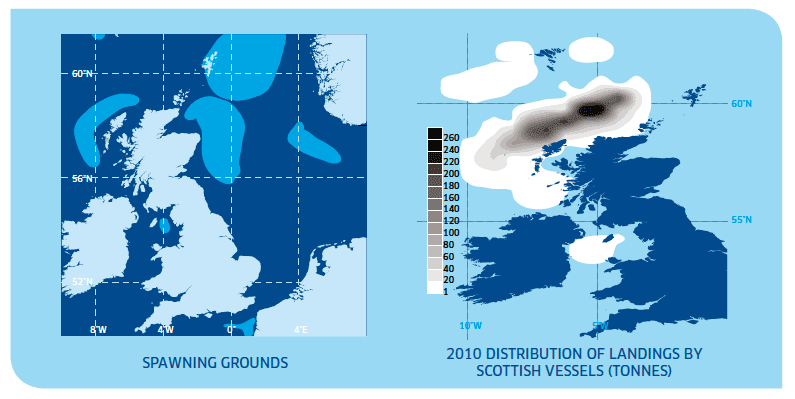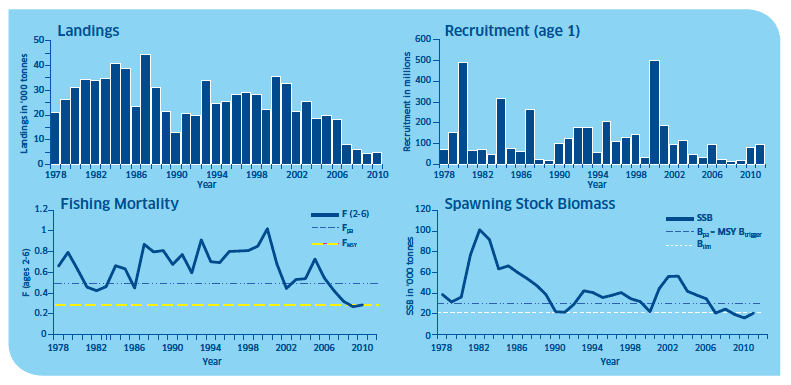Fish and Shellfish Stocks 2012
Fish and Shellfish Stocks 2012. State of Scottish fish stocks, TACs and biology of the stocks for 2012.
HADDOCK STOCKS — WEST OF SCOTLAND
Haddock ( Melanogrammus aeglefinus) to the west of Scotland is, by weight, one of the most important demersal species landed from this area. It is caught mainly by bottom trawlers which target mixed demersal fish assemblages. Discarding is still quite high in this area, with nearly 51% of the catch estimated to be thrown back.
2012 position : UK share 4,683 tonnes
Last Year : 1,561 tonnes
Landed into Scotland in 2010 : 2,407 tonnes
Value for 2010 : £2.9 million
Biology
The haddock is widely distributed around the west coast of Scotland and can be caught in most areas within the 200 m depth contour. The stocks occurring off the north-west coast of Scotland are usually identified according to the regions which support a fishery, but genetic and biological marker studies suggest the possibility of different populations of haddock. A continuous population of haddock is thought to extend from the west coast around to the north of Scotland. Results from tagging experiments and larval transport studies suggest that there may be links between west coast haddock and those in the North Sea.
The majority of haddock now mature at age two with usually all mature by age three. However, mature age two haddock spawn fewer eggs for a given size than an age three haddock. A three year old female of good size is able to produce around 300,000 eggs in a season and releases her eggs in a number of batches over many weeks. Spawning usually occurs in February and March and occurs in almost any area. There is major spawning between the Butt of Lewis and Shetland. Some larvae from the west coast spawning grounds can be transported to the North Sea, which they enter through the Fair Isle/Shetland Gap or to the north east of Shetland. Young haddock then spend the first few months of life in the upper water layers before adopting the demersal way of life. The survival rate of young haddock is very variable from year to year.
The diet of haddock varies with the size of the fish, the time of year, and with the locality. In the winter months haddock of all sizes feed mainly on worms, small molluscs, sea urchins and brittle stars. In the spring and summer, fish prey, especially sandeels, are important, particularly for the larger haddock. At other times Norway pout is the most common fish eaten. During the herring spawning season haddock will feed heavily on their eggs.

ICES ADVICE ON MANAGEMENT
Information Source: ICES advice 2011 ( http://www.ices.dk/committe/acom/comwork/report/2011/2011/had-scow.pdf). Quoted text in italics.

MSY and precautionary approach reference points
| Type |
Value |
|
|---|---|---|
| MSY Approach |
MSY B trigger |
30,000 t |
| F msy |
0.3 |
|
| Precautionary Approach |
B lim |
22,000 t |
| B pa |
30,000 t |
|
| F lim |
Not defined |
|
| F pa |
0.5 |
State of stock and advice
- Fishing mortality in 2010 has been estimated at about 0.29: this means that approximately 20%, by number, of all fish between 2 and 6 years of age were caught.
- The relatively strong 2006 and 2009 year classes have contributed to the rise of the spawning stock biomass in 2011, which is estimated to just be below B lim at 20,800 tonnes.
- Fishing mortality and biomass are both below their precautionary limits. However, fishing mortality is just below the level which is consistent with achieving maximum sustainable yield ( F 2010 ≈ F MSY ).
- The advice is in accordance with the MSY approach which recommends human consumption landings in 2012 of 10,200 tonnes for haddock in Division VIa.
A management plan is under development. It is not yet in operation and has still to be fully evaluated by ICES, therefore stock advice is not yet based on this plan.
The management plan should offer maximum protection to the haddock while recognising that they are caught in a mixed fishery. Attention should be given to the sporadic nature of recruitment in to the stock and how to manage the periods of poor recruitment interspersed with the larger, occasional pulses. In recent years around 50% of the total catch in weight has been discarded, so restricting landings alone may not achieve the necessary increase in SSB.
Discarding of haddock remains stubbornly high, with the majority of these fish discarded being one year olds. In 2010 the Nephrops fleet is estimated to have discarded approximately seven times that of the demersal fish fleet. The advice explicitly states that: "The selection pattern should be improved in the Nephrops ( TR2) fleet to reduce its high proportion of discards." Any measure to reduce discarding and to improve the fishing pattern should be actively encouraged. Such measures should include the adoption of a sorting grid as well as appropriately located square-meshed panels.
Management outcomes for 2012
At the December 2011 meeting in Brussels, the Council of Ministers decided that the international Total Allowable Catch for West of Scotland (VIa and Vb) haddock should be 6,015 tonnes, which is in line with the proposed management plan. The UK quota for 2012 is set at 4,683 tonnes.
To realise the TAC, adjustments to the existing bycatch regulations affecting haddock in previous years have been applied by the Commission. There are requirements to manage the haddock TAC uptake spatially in order to avoid increases in mortality on cod.
Contact
There is a problem
Thanks for your feedback